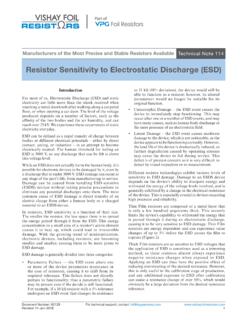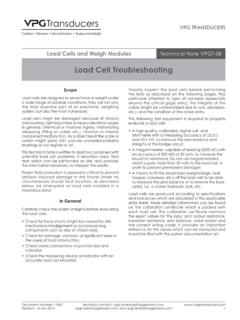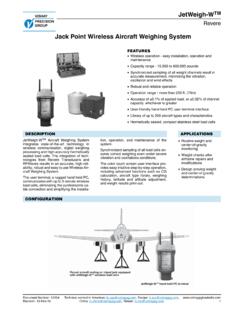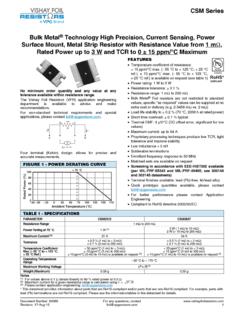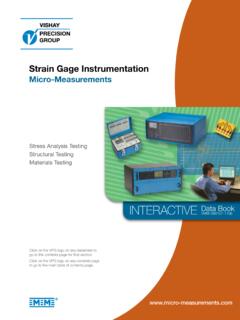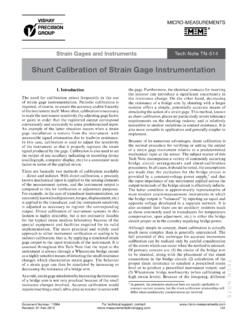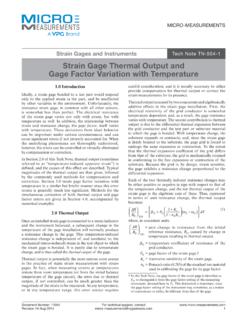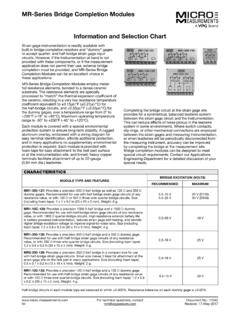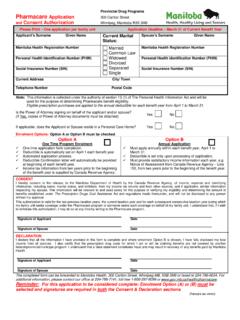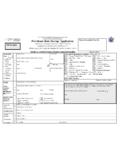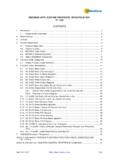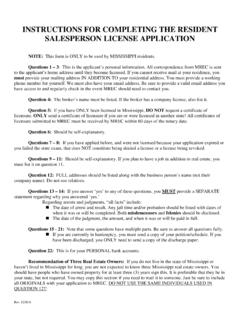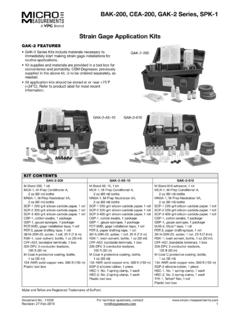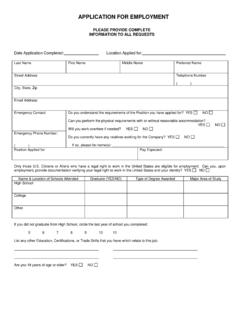Transcription of Strain Gage Rosettes: Selection, Application and Data ...
1 Tech Note TN-515 Strain gage Rosettes: selection , Application and Data ReductionStrain Gages and InstrumentsMICRO-MEASUREMENTSFor technical support, contact Number: 11065 Revision IntroductionA Strain gage rosette is, by definition, an arrangement of two or more closely positioned gage grids, separately oriented to measure the normal strains along different directions in the underlying surface of the test part. Rosettes are designed to perform a very practical and important function in experimental stress analysis.
2 It can be shown that for the not-uncommon case of the general biaxial stress state, with the principal directions unknown, three independent Strain measurements (in different directions) are required to determine the principal strains and stresses. And even when the principal directions are known in advance, two independent Strain measurements are needed to obtain the principal strains and meet the foregoing requirements, the Micro-Measurements manufactures three basic types of Strain gage rosettes (each in a variety of forms): Te e: two mutually perpendicular grids.
3 45 -Rectangular: three grids, with the second and third grids angularly displaced from the first grid by 45 and 90 , respectively. 60 -Delta: three grids, with the second and third grids 60 and 120 away, respectively, from the first gage patterns for the three rosette types are reproduced in Figure common with single-element Strain gages, rosettes are manufactured from different combinations of grid alloy and backing material to meet varying Application requirements. They are also offered in a number of gage lengths, noting that the gage length specified for a rosette refers to the active length of each individual grid within the rosette.
4 As illustrated in Figure 2, rectangular and delta rosettes may appear in any of several geometrically different, but functionally equivalent, forms. Guidance in choosing the most suitable rosette for a particular Application is provided in Section , where selection considerations are 1 Basic rosette types, classified by grid orientation: (a) tee; (b) 45 -rectangular; (c) 60 (a)5X (b)5X (c)RectangularDeltaFigure 2 Geometrically different, but functionally equivalent configurations of rectangular and delta gage Rosettes: selection , Application and Data ReductionFor technical questions, Note TN-515 Document Number: 11065 Revision: biaxial stress states occur very commonly in machine parts and structural members, it might be presumed that half or so of the Strain gages used in experimental stress analysis would be rosettes.
5 This does not seem to be the case, however, and ten percent (or less) rosette usage may be more nearly representative. To what degree this pattern of usage reflects an inclination for on-site makeup of rosettes from single-element gages, or simply an undue tendency to assume uniaxiality of the stress state, is an open question. At any rate, neither practice can generally be recommended for the accurate determination of principal must be appreciated that while the use of a Strain gage rosette is, in many cases, a necessary condition for obtaining the principal strains, it is not a sufficient condition for doing so accurately.
6 Knowledgeability in the selection and Application of rosettes is critical to their successful use in experimental stress analysis; and the information contained in this Tech Note is intended to help the user obtain reliably accurate principal Strain Rosette selection ConsiderationsA comprehensive guide for use in selecting Micro-Measurements Strain gages is provided in Reference 1. This publication should first be consulted for recommendations on the Strain -sensitive alloy, backing material, self-temperature-compensation number, gage length, and other Strain gage characteristics suitable to the expected Application .
7 In addition to basic parameters such as the foregoing, which must be considered in the selection of any Strain gage , two other parameters are important in rosette selection . These are: (1) the rosette type tee, rectangular, or delta; and (2) the rosette construction planar (single-plane) or stacked (layered).The tee rosette should be used only when the principal Strain directions are known in advance from other considerations. Cylindrical pressure vessels and shafts in torsion are two classical examples of the latter condition.
8 However, care must be exercised in all such cases that extraneous stresses (bending, axial stress, etc.) are not present, since these will affect the directions of the principal axes. Attention must also be given to nearby geometric irregularities, such as holes, ribs, or shoulders, which can locally alter the principal directions. The error magnitudes due to misalignment of a tee rosette from the principal axes are given in Reference 2. As a rule, if there is uncertainty about the principal directions, a three-element rectangular or delta rosette is preferable.
9 When necessary (and, using the proper data-reduction relationships), the tee rosette can be installed with its axes at any precisely known angle from the principal axes; but greatest accuracy will be achieved by alignment along the principal directions. In the latter case, except for the readily corrected error due to transverse sensitivity, the two gage elements in the rosette indicate the corresponding principal strains the directions of the principal strains are unknown, a three-element rectangular or delta rosette is always required; and the rosette can be installed without regard to orientation.
10 The data-reduction relationships given in Section yield not only the principal strains, but also the directions for the principal axes relative to the reference grid (Grid 1) of the rosette. Functionally, there is little choice between the rectangular and delta rosettes. Because the gage axes in the delta rosette have the maximum possible uniform angular separation (effectively 120 ), this rosette is presumed to produce the optimum sampling of the underlying Strain distribution. Rectangular rosettes have historically been the more popular of the two, primarily because the data-reduction relationships are somewhat simpler.

